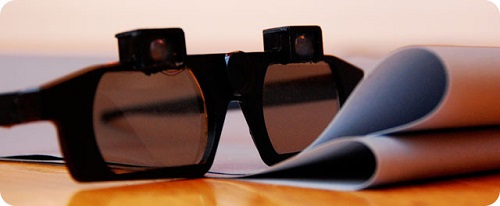CastAR is a pair of 3D holographic augmented-reality glasses capable of retaining projected images in place, allowing users to interact and move about them freely. Inspired by the ‘80s vision of virtual reality as seen in Star Wars films, the glasses take the augmented-reality vision of Google’s Glass to an entire new level with the use of an RFID tracking grid for precise tracking, and three-dimensional input device for virtually manipulating objects in real time.

How do they work?!
The augmented-reality system is dependent on two components: the castAR glasses themselves, which project the images, and a special surface for receiving them. Projection is carried out by the use of two 120-Hz micro-protectors, one for each eye, situated atop the lenses in the frame. A miniature 120-Hz, low-latency camera is positioned in-between the projectors to scan for infrared identification markers placed on the special surface. These markers allow the camera to track your head position and dictate to the proprietary software exactly how the hologram should appear to you based on your tilt and distance from the surface. The video signal is then transferred to the glasses through an HDMI cable to display the images.
A reflective surface
In order for projected augmented reality to function correctly and maintain image fidelity, a unifying surface must be used because light does not evenly reflect off all materials. For this reason, included in the castAR solution is a special surface made of the same ultra-reflective sheeting material used in traffic signs. This surface ensures that the appropriate amount of light is reflected back to the glasses and that the amount of light scattering is kept to a minimum. As a result, multiple people can view a single surface at the same time while keeping each other’s individual views private.

Seen above is castAR in its prototype stage
RFID tracking grid
The same system capable of producing virtual-reality objects in the physical world (as seen through the castAR glasses) can also perform augmented-reality feats through the inclusion of RFID tags. Situated beneath each surface is an RFID tracking grid able to identify the position of any RFID-equipped objected place atop. This enables you to associate tags with specifics objects such as miniatures and board games figures to commence interactive games where health bars and status effects are only visible to the wearer of the glasses. RFID tags can be manually inserted through DIY methods or by using special RFID-equipped bases provided by the castAR designers. The bases are manufactured in sizes standard to miniature figures to easily snap into place. These come with a standard RFID tag or with an additional circuit board to facilitate two communications, allowing for massive open-source possibilities.
Magic Wand
The Magic Wand is castAR’s controller and 3D input device for manipulating objects in virtual space. It includes a trigger, input buttons, and analog joystick precise control and can even track its position in 3D environments.
Visit castAR’s Kickstarter page to secure a unit
Advertisement
Learn more about Electronic Products Magazine





